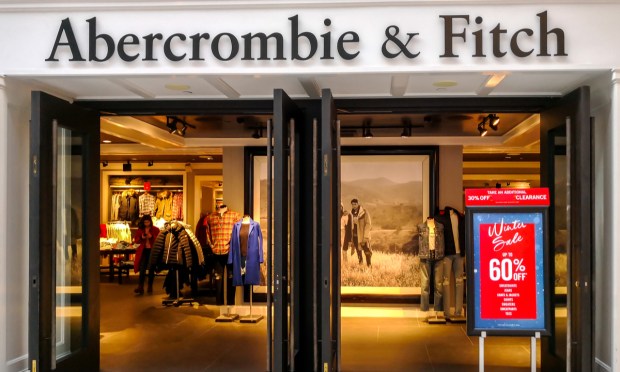Abercrombie Transforms Controversy Into Profits

Abercrombie & Fitch has made significant strides since its days of provocative advertising campaigns that showcased young shirtless male models, turning the brand into a sought-after fashion symbol among millennials.
On Wednesday (May 24) the brand and retailer reported it has surpassed analysts’ expectations by reporting an unexpected profit and raising its outlook for the entire year. These figures demonstrate that despite economic uncertainty, American consumers are inclined to allocate their money toward discretionary purchases like acid-washed jeans and polo shirts.
But before getting to this moment, Abercrombie was infamous for its entitled exclusivity as it refused to produce clothing in sizes XL or XXL for an extended period of time.
“Abercrombie’s offering is resonating meaningfully with our target customer, setting several other sales records this quarter across genders, categories and geographies,” Chief Executive Officer Fran Horowitz said in a statement Wednesday.
In the first quarter, the company recorded a net income of $16.57 million, a significant improvement over the $16.46 million loss reported in the previous year. Moreover, sales experienced a positive growth trajectory, reaching $836 million, surpassing the $812.8 million recorded in the same period a year ago.
Additionally, Abercrombie disclosed that its same-store sales grew 3%, surpassing the expectations of analysts who had predicted a 1% decline.
Additionally, the retailer anticipated net sales growth ranging from 2% to 4% for the current year, surpassing its previous projections of 1% to 3%.
Abercrombie & Fitch’s quarterly results came as other discretionary retailers are witnessing a decline in consumer spending. Several major retailers have issued warnings about potential challenges, highlighting a decrease in American bank account balances and a rise in debt.
In light of these circumstances, Abercrombie & Fitch reported a complete turnaround.
Neil Saunders, managing director of GlobalData, said the key to Abercrombie’s success can be attributed to the skills and mindset of its management. He highlighted their strong focus on the consumer and the constant drive to comprehend their needs. Once these needs are understood, the management team efficiently and effectively delivers.
Abercrombie’s Scandalous Past
Abercrombie’s past is marked by a series of controversies that have marred its reputation. One prominent issue was the brand’s provocative marketing campaigns during the 1990s and 2000s, which featured young, shirtless male models.
“We go after the cool kids. We go after the attractive all-American kid with a great attitude and a lot of friends,” former CEO Mike Jeffries said in 2006. “Are we exclusionary? Absolutely.”
While these campaigns were successful in cultivating a preppy and aspirational image, they also drew criticism for their overtly sexualized nature, with some accusing Abercrombie of objectifying and exploiting young people.
Another controversy revolved around Abercrombie’s exclusivity in sizing. For a considerable period, the brand faced backlash for its refusal to produce clothing in larger sizes, specifically XL or XXL. This exclusionary approach alienated many potential customers and led to accusations of body shaming and discrimination.
Furthermore, Abercrombie faced allegations of fostering a discriminatory and toxic work environment. Former employees shared accounts of racial discrimination, unequal treatment, and body-shaming practices within the company. These revelations prompted lawsuits and settlements related to race and sex discrimination, as well as harassment.
But while the brand’s actions led to alienating its customer base, fast-fashion retailers like H&M capitalized on the opportunity to attract those customers during and after the 2008 recession. Abercrombie experienced a decline in sales. By the time Jeffries departed in 2014, the brand had garnered a toxic reputation.
However, over the past decade, the brand has made efforts to distance itself from that reputation and redirect its focus toward promoting casual, comfortable apparel while prioritizing size-inclusive options.
Hollister’s Softer Outcome
Abercrombie-owned Hollister has reported a 6.7% drop in sales compared to the previous year. This decline can be attributed to the challenging conditions of sluggish international markets and unfavorable exchange rates. Additionally, Hollister has been hurt by the trend of parents reducing their purchases of children’s items.
Nevertheless, the retailer is seeking to improve merchandise offerings during the summer and fall seasons.
Overall Performance
Overall the business reported a big improvement. The previous year’s loss of $16.5 million was transformed into a net income of $16.6 million, driven by sales gains and reduced freight expenses. However, the company was noted inflation in raw material costs, which partially offset the gains.
Abercrombie’s inventory management was evident through a reduction of about 20%, indicating a minimized risk of profit erosion through discounting.
Furthermore, the company’s ability to swiftly adapt to market trends and its agile production capabilities enabled a focus on items with high sales potential.

